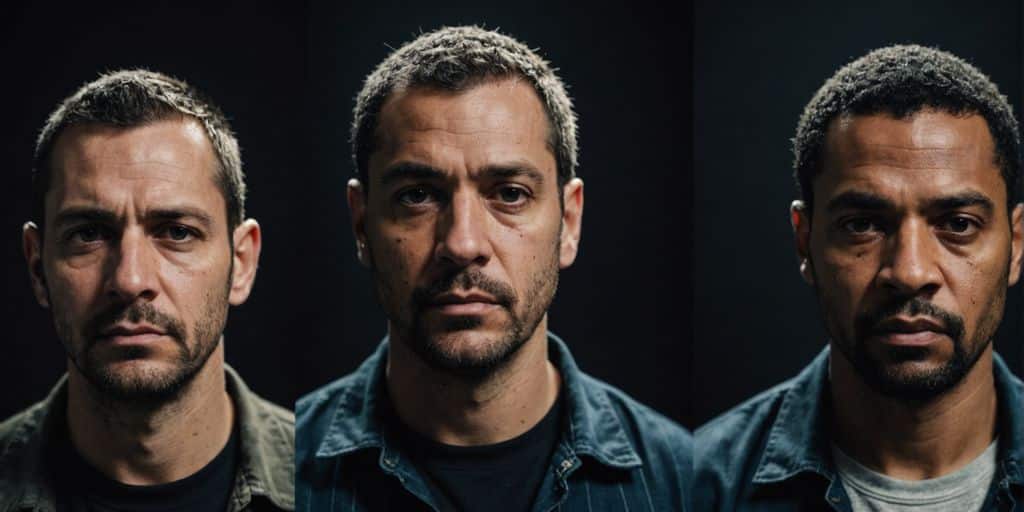Throughout history, some criminals have become infamous for their actions, leaving a lasting impact on society. These individuals often possess traits like intelligence, charisma, and a disregard for the law, which make their stories both fascinating and terrifying. This article delves into the lives of some of the most notorious criminals, exploring their rise to infamy and the legacy they left behind.
Key Takeaways
- Pablo Escobar, known as the King of Cocaine, built a powerful drug empire with the Medellín Cartel but met a violent end.
- Osama bin Laden, the mastermind behind the September 11 attacks, led the terrorist group al-Qaeda until his death in 2011.
- Al Capone, a notorious gangster of the Prohibition era, was eventually imprisoned for tax evasion.
- Ted Bundy, a charming yet brutal serial killer, was executed after confessing to numerous murders.
- Jack the Ripper remains an unsolved mystery, with his gruesome crimes in London still captivating the public’s imagination.
Pablo Escobar: The King of Cocaine
Rise to Power
Pablo Escobar, often called the King of Cocaine, began his criminal career in the streets of Medellín, Colombia. He quickly rose through the ranks, using his cunning and ruthlessness to establish a vast drug empire. By the late 1970s, Escobar had become a key player in the cocaine trade, smuggling tons of the drug into the United States and other countries.
The Medellín Cartel
Escobar’s Medellín Cartel was one of the most powerful and violent criminal organizations in history. The cartel controlled a significant portion of the global cocaine market, generating billions of dollars in revenue. Escobar’s wealth and influence were so immense that he was able to bribe or intimidate many government officials, law enforcement officers, and even entire communities.
Downfall and Death
Despite his power, Escobar’s reign came to a violent end. In the early 1990s, the Colombian government, with support from the United States, launched a massive manhunt to capture him. After years of evading capture, Escobar was finally located and killed in a rooftop shootout in Medellín in 1993. More than two decades after his death, Pablo Escobar remains as well known as he was during his heyday as the head of the Medellín drug cartel.
Osama bin Laden: The Face of Terrorism
Osama bin Laden founded al-Qaeda in the late 1980s. The group aimed to fight against the Soviet invasion of Afghanistan. Over time, it evolved into a global terrorist network. Bin Laden’s leadership and vision turned al-Qaeda into a serious threat to many countries, especially the United States.
The most infamous act of terrorism by al-Qaeda was the September 11 attacks in 2001. Nineteen terrorists hijacked four planes, crashing them into the World Trade Center, the Pentagon, and a field in Pennsylvania. This tragic event resulted in nearly 3,000 deaths and changed the world forever.
After the September 11 attacks, the United States launched a massive manhunt for bin Laden. He managed to evade capture for nearly a decade. Finally, in May 2011, U.S. Navy SEALs found and killed him in a compound in Abbottabad, Pakistan. His death marked the end of a long and intense search for one of the world’s most wanted men.
Al Capone: The Prohibition Era’s Most Notorious Gangster
Alphonse Gabriel Capone, sometimes known by the nickname "Scarface," was born in Brooklyn, New York, in 1899. He was the son of Italian immigrants and grew up in a rough neighborhood. Capone dropped out of school in the sixth grade and quickly became involved in petty crime. His early criminal activities included working for small-time gangs and engaging in minor thefts and assaults. Capone’s early life set the stage for his future as one of America’s most infamous gangsters.
In the 1920s, Capone moved to Chicago and joined the criminal organization led by Johnny Torrio. When Torrio retired, Capone took over and expanded the gang’s operations. The Chicago Outfit, as it was known, became a powerful force in the city’s underworld. Capone’s empire included illegal breweries, speakeasies, and gambling dens. He used violence and intimidation to maintain control, and his gang was responsible for numerous murders, including the infamous St. Valentine’s Day Massacre in 1929.
Despite his criminal activities, Capone managed to avoid serious legal trouble for many years. However, in 1931, he was finally arrested and charged with tax evasion. Capone was found guilty and sentenced to 11 years in federal prison. He served time in several prisons, including the infamous Alcatraz. Capone’s health deteriorated while he was incarcerated, and he was released in 1939 due to his declining condition. He spent the last years of his life in Florida, where he died in 1947.
Capone’s life of crime and his eventual downfall serve as a stark reminder of the consequences of a life lived outside the law.
Ted Bundy: The Charming Serial Killer
Early Life and Psychological Profile
Ted Bundy was born in 1946 in Vermont. He had a troubled childhood, marked by confusion about his parentage and a difficult relationship with his stepfather. Bundy was known for his intelligence and charm, which he used to mask his darker tendencies. His charming appearance helped him become somewhat of a celebrity during his trial.
Crimes and Modus Operandi
Bundy’s crime spree began in the 1970s, targeting young women across several states, including Washington, Utah, and Colorado. He often lured his victims by pretending to be injured or impersonating an authority figure. Once he gained their trust, he would abduct, assault, and murder them. Bundy admitted to 30 murders before his execution in 1989, but the actual number of victims is believed to be higher.
Trial and Execution
Bundy’s trial was a media sensation, partly because he chose to represent himself in court. The trial was one of the first to be televised, and Bundy used the platform to manipulate public perception. He was convicted of multiple murders and sentenced to death. Bundy was executed in the electric chair in Florida in 1989, bringing an end to his reign of terror.
Jack the Ripper: The Unsolved Mystery
In 1888, a series of gruesome murders shocked London’s East End. The killer, who came to be known as Jack the Ripper, targeted at least five women, all of whom were prostitutes. The brutality of the crimes was unprecedented, with the victims’ bodies often mutilated in horrific ways. The true identity of the serial killer remains unknown, making it one of the most famous unsolved mysteries in history.
Over the years, more than 100 suspects have been proposed, ranging from local butchers to members of the British royal family. Some theories even suggest that the killer might have been a woman. Despite numerous investigations and countless theories, no one has been able to definitively identify Jack the Ripper. This has led to endless speculation and a plethora of books, documentaries, and even viral TikTok theories.
The mystery of Jack the Ripper has had a lasting impact on popular culture. The story has inspired numerous films, books, and TV shows. The fascination with the case continues to this day, as people are still intrigued by the idea of solving the mystery. The case has also influenced the way we think about serial killers and criminal investigations.
The true identity of the serial killer remains unknown, but unsolved mysteries volume 4, episode 1 explores theories as to who he might have been.
Charles Manson: The Cult Leader
Charles Manson is one of the most infamous criminals in American history. By 1968, he had become the leader of the “family,” a communal religious cult dedicated to studying and implementing his eccentric religious teachings. Manson’s influence over his followers led to a series of brutal murders that shocked the nation.
Joaquín ‘El Chapo’ Guzmán: The Drug Lord
Joaquín Guzmán, also known as El Chapo, rose to power in the Sinaloa Cartel, one of the most powerful and notorious criminal organizations in Mexico. His journey began in the 1980s, and he quickly became known for his strategic mind and ruthless tactics. Guzmán’s ability to outsmart law enforcement and rival cartels helped him climb the ranks rapidly.
El Chapo’s story is filled with dramatic escapes that captured the world’s attention. His most famous escape occurred in 2015 when he fled from a maximum-security prison through a mile-long tunnel. This escape highlighted his extensive resources and the loyalty of his followers. Guzmán’s ability to evade capture made him a legend in the criminal world.
Despite his numerous escapes, El Chapo was finally captured in 2016. His arrest marked the end of an era for the Sinaloa Cartel. In 2019, he was extradited to the United States, where he faced multiple charges, including drug trafficking and money laundering. Guzmán was sentenced to life in prison, bringing an end to his reign as one of the most powerful drug lords in history.
Bonnie and Clyde: The Criminal Couple
Early Lives and Meeting
Bonnie Parker and Clyde Barrow were two young individuals from Texas who met during the Great Depression. Bonnie was a waitress, and Clyde had already started his life of crime. Their meeting sparked a partnership that would become infamous.
Crime Spree Across America
The couple, along with their gang, embarked on a series of brazen robberies and murders across the United States. They targeted small stores, gas stations, and banks. Their crime spree was marked by frequent shootouts with the police, making them notorious figures in American history.
Final Ambush
Their criminal activities eventually led to their downfall. In May 1934, law enforcement officers set up an ambush in Louisiana. Bonnie and Clyde were killed in a hail of bullets, ending their infamous crime spree. Their deaths marked the end of one of the most famous criminal partnerships in history.
Bonnie and Clyde’s story remains a symbol of the lawlessness and desperation of the Great Depression era.
Jesse James: The Outlaw Legend
Jesse James, an American outlaw, began his life of crime during the Civil War. He joined a group of Confederate guerrillas, known for their brutal tactics. This early exposure to violence shaped his future as a notorious criminal.
After the war, Jesse and his brother Frank formed the James-Younger Gang. They became infamous for their daring bank and train robberies. The gang’s activities made them legends in the American Old West, admired by some for their boldness.
Jesse James’ life of crime ended when he was betrayed by a member of his own gang. Robert Ford shot him in the back, hoping to collect a reward. Jesse’s death only added to his legend, making him a folk hero in Missouri and beyond.
Sites devoted to famed outlaw Jesse James are located northeast of the city in Liberty and Kearney. His story continues to captivate people, reflecting the complex legacy of this infamous figure.
John Dillinger: The Infamous Bank Robber
John Dillinger was born in 1903 in Indianapolis, Indiana. He had a troubled childhood and got involved in petty crimes early on. His first major crime was a botched grocery store robbery, which led to his first stint in prison. This experience hardened him and set him on a path of more serious criminal activities.
Dillinger quickly became notorious for his daring bank robberies during the Great Depression. He commanded the Dillinger Gang, which was accused of robbing twenty-four banks and four police stations. His ability to escape from prison multiple times only added to his legend. Dillinger’s most famous escape involved carving a fake gun out of wood and using it to bluff his way out of jail.
Despite his criminal success, Dillinger’s luck ran out in 1934. After a long manhunt, he was finally tracked down by the FBI. On July 22, 1934, Dillinger was ambushed and shot outside the Biograph Theater in Chicago. His death marked the end of an era of high-profile bank robbers in America.
Conclusion
In exploring the stories of the world’s most notorious criminals, we see a mix of intelligence, charisma, and audacity. These individuals often outsmarted law enforcement and captivated the public, becoming larger-than-life figures. Their tales, shaped by media and public perception, reveal much about society’s values and fears. While their actions were reprehensible, their stories continue to fascinate, reminding us of the thin line between right and wrong. Ultimately, these criminals’ legacies serve as a reflection of the times and the enduring human interest in the darker aspects of history.
Frequently Asked Questions
Who was Pablo Escobar?
Pablo Escobar was a Colombian drug lord and the leader of the Medellín Cartel. He was known as the ‘King of Cocaine’ and was one of the wealthiest criminals in history.
What is al-Qaeda?
Al-Qaeda is a militant Islamist organization founded by Osama bin Laden. It is known for carrying out the September 11 attacks in 2001.
Who was Al Capone?
Al Capone was a notorious American gangster during the Prohibition era. He led a crime syndicate in Chicago and was involved in bootlegging, gambling, and other illegal activities.
What crimes did Ted Bundy commit?
Ted Bundy was an American serial killer who kidnapped, raped, and murdered numerous young women in the 1970s. He was known for his charm and intelligence.
Why is Jack the Ripper famous?
Jack the Ripper is famous for being an unidentified serial killer who murdered several women in London in 1888. The case remains unsolved, making it one of the most famous mysteries in criminal history.
Who was Charles Manson?
Charles Manson was an American criminal and cult leader. He led the Manson Family, whose members committed several murders in the late 1960s, including the infamous Tate-LaBianca murders.
What is the Sinaloa Cartel?
The Sinaloa Cartel is a powerful Mexican drug trafficking organization. Joaquín ‘El Chapo’ Guzmán was one of its most prominent leaders, known for his dramatic prison escapes and eventual capture.
Who were Bonnie and Clyde?
Bonnie and Clyde were an American criminal couple who traveled across the Central United States during the Great Depression, committing bank robberies and other crimes. They were eventually ambushed and killed by law enforcement.




